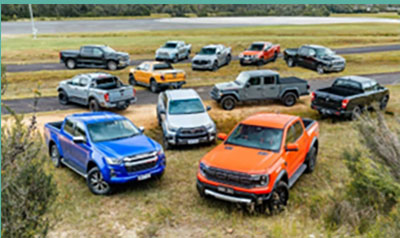Life on the West Island - Car problems
24 January 2024

When West Islanders hear talk of “car problems,’ their thoughts usually turn to mechanical difficulties or repairs to remedy impacts from other vehicles or our pesky native wildlife. But it turns out that as a nation we have much more pressing car problems which are proving almost insoluble. The two main ones relate to a plethora of gas guzzling large utes and SUVs; and to spiralling congestion, especially in the centres of our cities and large towns.
The first of these issues is highlighted in this recent commentary by respected senior economist Richard Denniss:
Australia has a ‘big car’ problem, we have too many SUVs and utes and we keep getting more of them. In 2023 all ten best-selling new car models were either SUVs or utes, over half of all new car sales were SUVs (55.8%) and nearly a quarter (22.5%) were light commercial vehicles (a category mostly representing utes). Big cars generate more pollution, are detrimental to road safety and damage roads – and this is being driven through government subsidies.
Denniss elaborated in a follow-up radio interview with a hostile SUV-driving host:
If you want to improve safety on our roads, or you want to help people with cost of living or reduce greenhouse gas emissions, then having 78% of new cars as SUVs or utes is a problem.
Over the last few weeks, I have been actively engaged in the debate around the rapid growth of large twin-cab utes and SUVs on Australian roads. To be clear, I haven’t said such cars should be banned, but I have taken the opportunity to remind people that research shows tax concessions are a major reason why, unlike most cities outside North America, our cities are full of vehicles designed to carry over a tonne of cargo.
Defenders of Australia’s massive fossil fuel export plans often point to the need to focus on domestic emissions, but those defenders are largely silent about the contradiction between Australia’s targets to reduce domestic emissions and the rapid growth of inefficient vehicles on our roads over the next 10 years. Apart from Russia, Australia is the only developed country with no mandatory fuel efficiency standards.
In an attempt to garner votes from “tradies,” the Morrison government introduced massive tax concessions for purchases of utes, including twin-cab family SUVs, so that it is commonplace to see families using these huge, inefficient vehicles to do the shopping, drop the kids at school or go to the beach. They pose a major threat to smaller vehicles or other SUVs in collisions, with much higher casualty and injury rates in accidents involving such “tax subsidised behemoths,” as they are described by Richard Denniss.
Then there are the problems of congestion, delay and road rage in West Island cities and towns. While this is most often thought of as an issue for city centres, relatively small rural communities such as Byron Bay, Tanunda and Kiama are experiencing severe problems with congested roads and parking.
Swiss international relations and public policy expert Olivia Chollet (now studying at ANU in Canberra) gave a number of examples of world cities which are tackling congestion problems. This is her brief summary of Oslo’s approach:
Launched in 2016 as part of Oslo’s climate and energy strategy, the programme aimed at “handing the urban spaces back to the people” by improving accessibility and liveability.
Instead of a complete ban on cars in the inner-city, street parking spaces were removed to make driving less attractive. Exceptions were made for people with a disability, as well as for deliveries, emergencies, and tradespeople. To compensate for the reduced parking, public transport to and from the city centre was improved. The space freed up by parking spaces was devoted to improving the quality of city life. Green spaces were expanded, lighting was improved, art was added to common spaces, and public infrastructure such as toilets, fountains and furniture was upgraded.
The programme delivered so many health, safety and environment benefits that Oslo was named the 2019 European Green Capital for its efforts. The programme is now widely considered a blueprint for other city centres wanting to go car-free.
The success of the programme was underpinned by careful planning and implementation. The public was actively involved through a bottom-up approach to planning changes (this included workshops, door-to-door and street engagement, and funding schemes for community-building projects). By incrementally implementing the project over three years, planners made room for continuous monitoring and review, as well as any necessary negotiations with local roadside businesses.
Some West Island cities are taking steps in the same direction. For instance, Adelaide has free inner city and suburban loop bus services to allow passengers to move around from suburb to suburb without transiting through the city centre. It also provides free travel on trains, buses and trams to major sports and arts events held in or near the CBD.
Chollet also reported: Melbourne has implemented free public transport in the CBD and is looking to restrict private cars from transiting through it, while Canberra and Sydney are considering car-free days and Perth is building bridges for pedestrians and cyclists.
But the West Island is a long way from tackling the big issues of our car-dependent society and its heavy use of fuel-inefficient SUVs and utes for domestic travel, adding to the nation’s carbon emissions and our rising contributions to global heating. These car problems could be tackled by implementing fuel efficiency standards, removing subsidies for inefficient “commercial” vehicles and encouraging the transition to electric vehicles. But do we have the political will or the community support for such vital reforms?